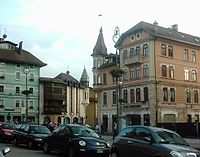You can help expand this article with text translated from the corresponding article in Italian. Click [show] for important translation instructions.
|
Asiago
Slege | |
|---|---|
| Comune di Asiago | |
 Asiago | |
| Coordinates: 45°52′N 11°31′E / 45.867°N 11.517°E | |
| Country | Italy |
| Region | Veneto |
| Province | Vicenza (VI) |
| Frazioni | Sasso |
| Government | |
| • Mayor | Roberto Rigoni Stern |
| Area | |
• Total | 162 km2 (63 sq mi) |
| Elevation | 1,001 m (3,284 ft) |
| Population (31 December 2014)[2] | |
• Total | 6,462 |
| • Density | 40/km2 (100/sq mi) |
| Demonym | Asiaghesi/Slegar |
| Time zone | UTC+1 (CET) |
| • Summer (DST) | UTC+2 (CEST) |
| Postal code | 36012 |
| Dialing code | 0424 |
| Patron saint | St. Matthew |
| Saint day | 21 September |
| Website | Official website |
Asiago (Italian: [aˈzjaːɡo]; Venetian: Axiago, Cimbrian: Slege, German: Schlägen [ˈʃlɛːɡn̩]) is a minor township (population roughly 6,500) with the title of city[1] in the surrounding plateau region (the Altopiano di Asiago or Altopiano dei Sette Comuni, Asiago plateau) in the Province of Vicenza in the Veneto region of Northeastern Italy. It is near the border between the Veneto and Trentino-Alto Adige/Südtirol regions in the foothills of the Alps, approximately equidistant (60 km) from Trento to the west and Vicenza to the south. The Asiago region is the origin of Asiago cheese. The town was the site of a major battle between Austrian and Italian forces on the Alpine Front of World War I. It is a major ski resort destination, and the site of the Astrophysical Observatory of Asiago, operated by the University of Padua.
- ^ "Superficie di Comuni Province e Regioni italiane al 9 ottobre 2011". Italian National Institute of Statistics. Retrieved 16 March 2019.
- ^ All demographics and other statistics from the Italian statistical institute (Istat)




